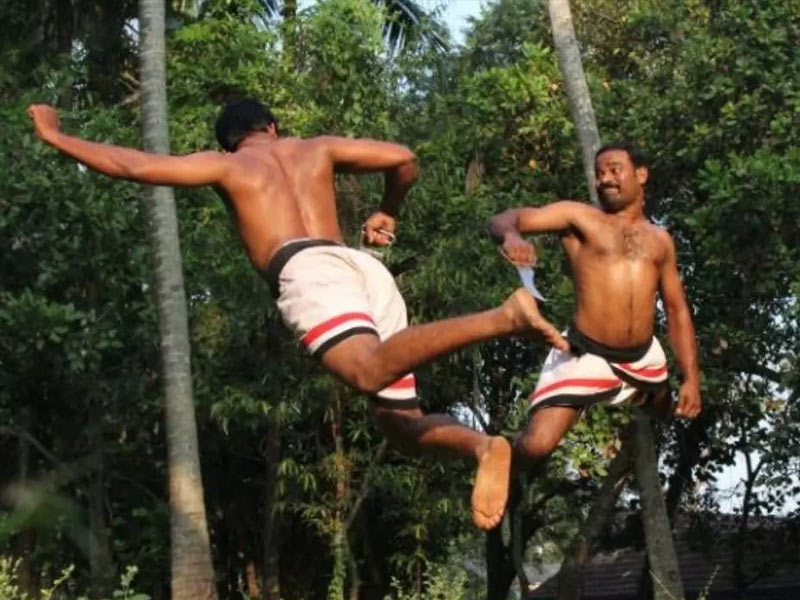Kalaripayattu, sometimes written Kalarippayattu, is an ancient martial technique that originated in Kerala, a tiny state in southern India, but is now renowned and practiced worldwide. The precise moment of its origin, on the other hand, cannot be determined with any degree of confidence. Some say that in its most primitive form, Kalaripayattu was used by the early people of this forested and hilly region to hunt wild animals before it was polished into a systematic style of warfare efficient enough to overcome adversaries and protect themselves.
Mythologists say that Kalaripayattu has a long history, having been brought by Lord Parasurama, the sixth avatar of Lord Vishnu after he recovered Kerala from the Arabian Sea. While historians deny such claims, there is no agreement among them on the date of its origin, which they place anywhere between 200 BCE and 600 CE, and its peak popularity during the 14th and 16th centuries.
Among all of these claims and counter-claims, one constant has been the amazement with which chroniclers and poets of different eras documented the intricacy of the methods, the liquid beauty of the motions, and the remarkable flexibility Kalaripayattu practitioners.

With very little tangible evidence to determine its beginnings, if one searches further, one discovers explicit allusions to Kalaripayattu in songs that had only an oral legacy to speak about for a long time.
Because there is a frequent reference of great masters who supervised the activities of a hundred and eight kalaris or training centers/arenas, and there are innumerable allusions to house names like “Kalaripparambu” and “Kalariyullathil” that openly point to the link with this martial art, it has to be inferred that some form of Kalaripayattu was taught virtually in every village in Kerala. Kalaris was always located near Devi temples, and the teacher was known as “Kuruppu” or “Gurukkal.”
Traditionally, proficiency in Kalarippayattu has been connected with masculinity. People who couldn’t handle the sword were deficient in masculinity and deserved to live as slaves. However, there are allusions to female warriors who can compete with male equivalents in all elements of martial arts.
For many people in India, martial arts were a way of life. However, during the British rule of India, martial arts suffered significant setbacks. The governing British were opposed to the practice of practicing with and carrying weapons. Laws were enacted and vigorously enforced to prohibit individuals from practicing and training in Kalarippayattu. The British enacted these rules to prevent any sort of mutiny or insurrection among the locals. However, the British had misjudged India’s passion for martial arts, and Kalarippayattu was covertly performed and kept alive under the British colonial control of India.
People in remote regions practiced the technique to avoid conflict with authorities. Thus, one of India’s primary martial arts survived the dark ages when its practices were restricted. When India gained independence, martial arts became popular again because they could again be performed freely. Kalaripayattu’s lost glory was gradually and steadily reclaimed. Many kalarippayattu techniques and postures are said to be inspired by the raw strength of animals and are named after them.
It is often assumed that this skill evolved in the woodlands as hunters watched the combat methods of various animals.
Today, martial arts are regaining popularity in India. Kalaripayattu is currently extensively practiced across Kerala, the outskirts of Karnataka and Tamil Nadu, and Sri Lanka. Kalaripayattu is now a source of income for many Kerala residents since performances are now held for visitors.
Unlike many other Indian martial disciplines, Kalaripayattu has withstood the test of time. Kalaripayattu has historically proven to be one of India’s most ancient martial arts. It is still practiced by many in Southern India.

Shiva is supposed to have taught Parasurama the technique of Kalaripayattu, which sprang from Shiva’s conflict with his father-in-law Daksha, one of the Prajapatis or ‘Lords Of Creation.’ Later, Parasurama taught his 21 followers the technique of Kalaripayattu, after which he established 108 Kalari (schools/gymnasiums) throughout Kerala, a Southern Indian state.
No documents chronicle Kalaripayattu’s historical roots, just narrative narratives structured as myth and folklore. The majority of these attributes Kalari’s origins to Lord Shiva, one of the three main Gods of the Hindu pantheon.
Shiva is represented as moral and paternal and the Lord of Time (Mahakala), the ‘Destroyer’ of all things. He is the Yogeshwara who lives in Kailas, deep in the meditation that keeps this World alive.
The kalarippayattu method grew more refined throughout the 9th century when troops used it to defend Kerala’s borders and the monarch. However, it reached its pinnacle of grandeur in the 11th and 12th centuries CE, during the 100-year war (300BC-1279AD) between the Cheras, Cholas, and Pandiyas.
Because Kalarippayattu is the earliest form of defense warfare, it is known as the mother of martial arts. Other Asian nations developed their own martial arts styles, such as karate, kungfu, and jiu-jitsu, which spread across China and other Far Eastern countries.
How are other Martial Arts related to Kalaripayattu?
The ethnic Indian martial art of Kalari Payat (Kalaripayattu) – meaning ‘Battleground’ or ‘Gymnasium’ – (Kalari), ‘Method’ or ‘Art’ – (Payatt) – has unique importance for Tibetan and Chinese martial arts practitioners.
According to legend, the Indian Buddhist Patriarch and Ch’an’ (Zen) Buddhism, Bodhidharma, established the Chinese Shaolin Temple martial art (450-523 AD).
The Essence of Kalaripayattu? Why was it Created?
Martial arts originated mostly in Southern India. Agastya Muni was a small-built guy – tiny and petite – who traveled indefinitely. He developed martial arts primarily to combat animals. Tigers formerly roamed this area in great quantity – now we can count them, we have eleven hundred tigers, but there was a period when there were thousands of them, along with other potentially deadly species. As a result, Agastya Muni devised a method for dealing with animals — for example, managing a tiger if one appeared.

As you can see, Kalari hasn’t changed its format. It’s not only about battling guys. Fighting with men was added afterward. He trained a few people in martial arts simply to keep the wildlife at bay while they traveled, and it is still alive. Some of the schools continue to look up to him and interact with him.
As a result, when people traveled to China after they crossed the Himalayas, they encountered wild men who were always on the lookout for an opportunity to attack the traveler. So they used what they had learned in dealing with wildlife to dealing with wild men. When they began employing it on individuals, the martial arts underwent a significant change.
From India through China and further into Southeast Asia, you will observe a transition from crouching martial art to a “standing up” martial art.
Also Read, The best Martial Artists in the World
As a result, it evolved into a distinct format. And when you battle guys, you must kill, or he will not stop. That is not the case with wildlife. They’ve come because they believe you’re food. And after you’ve made it plain to him that you’re a tough meal, he’ll go.
He’ll search for something simple to eat. As a result, martial arts evolved organically from a wonderful way to escape being someone’s food to something that can kill. This transition from Kalari to Karate will be visible.
Later on, in India, they began fighting with men, although they did not significantly alter the technique. Instead, they grabbed firearms. When fighting with humans, Kalari may not be as effective as Karate because they are standing on two legs in Karate. You’re attempting to look at something lower down in Kalari because we didn’t consider it a tool to combat other men; it was just seen as protecting against nature.

Kalari’s great instructor was Parashuram. Because of his incredible martial arts talents, he was able to destroy armies on his own. He taught at one school in Malabar from the north, and Agastya Muni’s school came from the south. While Parashuram’s approach employed a variety of weapons – hand weapons, throwing weapons, and different types of weaponry — Agastya Muni’s martial art evolved without the use of any weapons, relying solely on the power of the human hand.
Forms of Kalaripayattu or Vadivu of Kalaripayattu
The motions of Kalarippayattu, Kerala, would appear virtually familiar if you pay close attention. That’s because those motions were adapted from the environment of animal assaults. They also named various kalarippayattu postures after animals. There are eight different animal postures known as ‘Ashta Vadivu.’
- The elephant stance is known as Gajja Vadivu.
- It is the lion pose, Simha Vadivu.
- It is the cat position, Marjara Vadivu.
- The horse position is known as Ashwa Vadivu.
- Varaha Vadivu is a wild boar stance.
- The snake stance is known as Sarpa Vadivu.
- The rooster position is called Kukuda Vadivu.
- Matsya Vadivu is a fish stance.
The Kalarippayattu forms?
Suppose you believe Kalarippayattu is the most dangerous martial art. In that case, you are correct because the movements of this style were intended for battle and carnage. As a result, the learning process for Kalarippayattu requires rigorous training because the body must prepare for flexing and shaping the muscles, so a full body massage with coconut oil and other medicinal herbs is performed before beginning the practice of Kalarippayattu Kerala, which is divided into four parts:
MAIPAYAT

In Malayalam, Maipayat refers to synchronized and regulated body conditioning activities that involve the greatest utilization of all of the body’s muscles and joints. They arranged this in such a manner that it seems to be a single type of movement, including a sequence of exercises flexing each portion of the body from head to toe. Along with this, they taught activities like chaattom (jumping), ottam (running), marichil (somersaulting), and so on.
KOLTHARIPAYATTU

This is the second step of kalarippayattu instruction. This is where training with wooden weapons begins. For defense and fighting purposes, there are many different types of wooden weapons available, such as long canes, short staffs, and bent instruments with a stern grip known as ‘otta.’ Another method known as ‘Vaiithari’ is the spoken orders provided while making the motions, in which the combatants must perform 10 well-balanced moves with the long canes known as ‘kettukaari.’
ANKATHARIPAYATTU
After practicing the maneuvers with wooden weapons, the body’s muscles are flexed and aware of its motions. So at this point, you’ll be fighting with sharp weapons like swords and shields, as well as spears, daggers, and ‘urumi.’ Urumi is an incredible and gorgeous weapon. It is a long flexible blade that resembles a whip wrapped around the waist to conceal the sword’s length and ensure that no one notices the secret weapon.
VERUMKAI

This is Kalarippayattu’s last learning level. After you’ve mastered the techniques with your hands and body and your muscles can reflex, it’s time to fight barehanded for defense. After developing these reflexes, the fighter will defend himself or herself from any attack, including those using weapons. This is when the fighter transforms into a true kalarippayattu warrior.
Every country has its own martial arts tradition that it is proud of. However, it is unfortunate that Indians are unaware that the World’s most ancient and lethal martial art originated in India, yet they do not learn it. The number of people learning this art form is decreasing. But, in the World’s second-most populous country, what’s the harm in mastering the art of defense?




























